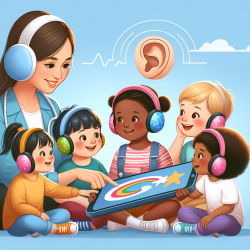As practitioners working in the field of special education and audiology, the pursuit of continuous improvement and professional development is crucial. The research article "Promotion de la sante auditive chez l'enfant à naitre et le jeune enfant" offers valuable insights into enhancing early childhood hearing health, presenting an opportunity for professionals to refine their skills and encourage further research in this area.
Understanding the Research
The publication focuses on a hearing health promotion program designed for use during prenatal and perinatal periods, extending up to 18 months postnatal. It sets forth three main objectives: enhancing hearing health care through primary prevention, stimulating the development of each child's auditory potential, and promoting the early identification of hearing disorders. These goals align with broader health and welfare initiatives, underscoring the importance of auditory health in early childhood development.
Implementing Research Outcomes in Practice
Practitioners can leverage the findings and recommendations from this research in several ways:
- Integrating Primary Prevention Strategies: By adopting the suggested primary prevention strategies, practitioners can work towards minimizing the risk factors associated with hearing loss. This includes addressing potential noise exposures in environments frequented by expectant mothers and young children, such as workplaces, incubators, and day-care centers.
- Stimulating Auditory Potential: Engaging in activities that stimulate auditory development is critical. Practitioners can incorporate specific exercises and interventions aimed at enhancing the auditory skills of infants and toddlers, thereby supporting their overall communication development.
- Early Identification and Intervention: The emphasis on early identification of hearing disorders is a call to action for practitioners to employ timely and effective screening methods. Early detection allows for the prompt initiation of interventions, which can significantly impact a child's communication skills and quality of life.
Encouraging Further Research
While the publication offers a comprehensive approach to hearing health care, it also highlights the need for ongoing research in this field. Practitioners are encouraged to explore the following areas:
- Effectiveness of Prevention Strategies: Further research is needed to evaluate the effectiveness of the proposed primary prevention strategies in reducing the incidence of hearing loss in early childhood.
- Innovative Auditory Stimulation Techniques: Investigating new and innovative techniques for stimulating auditory development could uncover more effective methods of supporting children's auditory and communication skills.
- Improving Early Detection Methods: Advancements in early detection methods for hearing disorders are crucial. Research aimed at developing more accurate, efficient, and accessible screening tools could facilitate earlier interventions.
Conclusion
"Promotion de la sante auditive chez l'enfant à naitre et le jeune enfant" serves as a foundational resource for practitioners committed to enhancing early childhood hearing health. By implementing the outcomes of this research and encouraging further investigation, professionals can make significant strides in improving auditory health care for children. This not only supports the individual development of each child but also contributes to the broader goal of fostering healthier communities.
For practitioners interested in delving deeper into the research and its implications, accessing the original publication is essential. To read the original research paper, please follow this link: Promotion de la sante auditive chez l'enfant à naitre et le jeune enfant.










